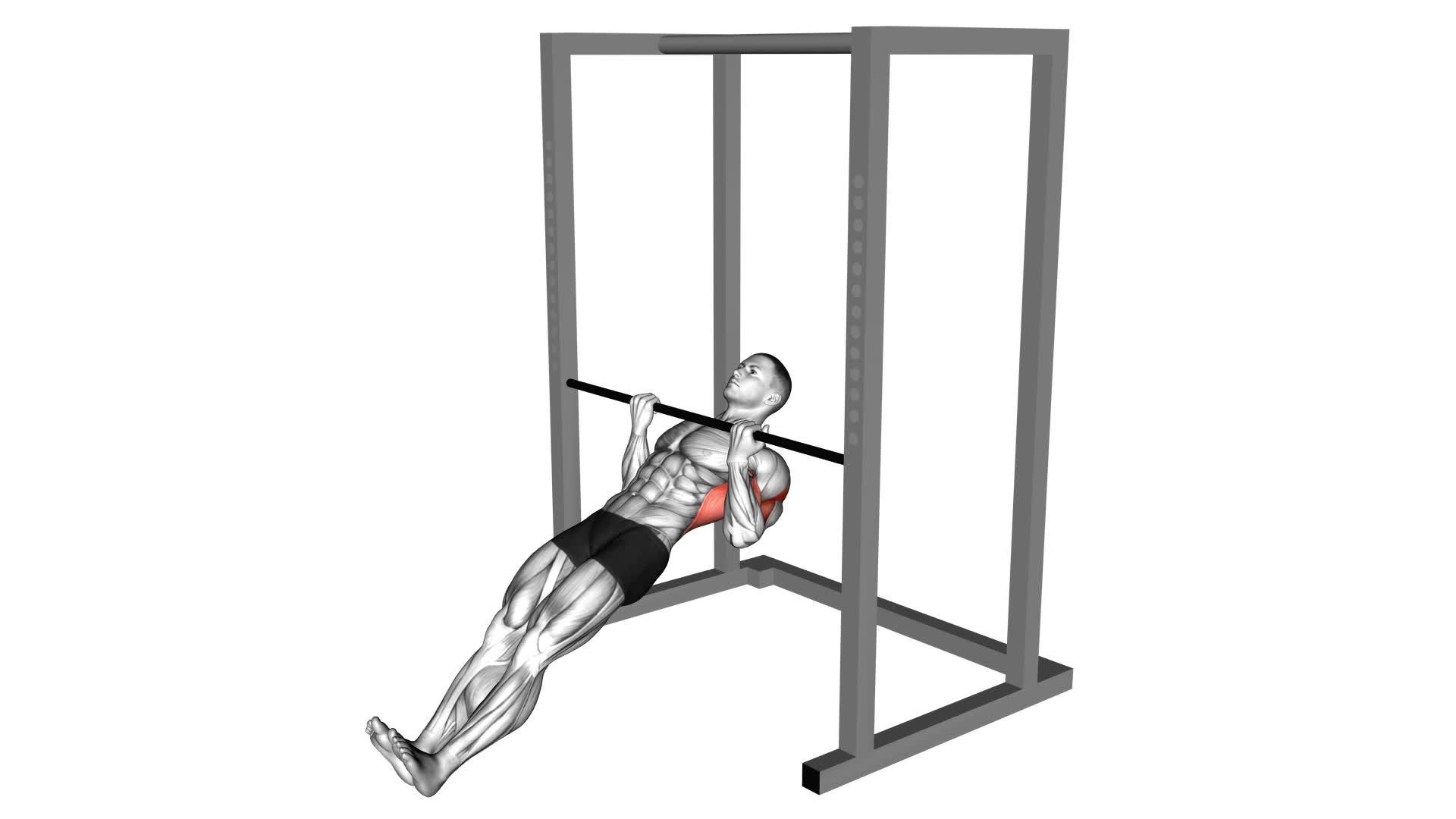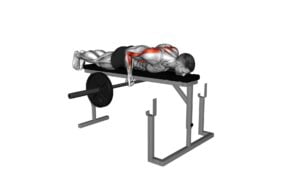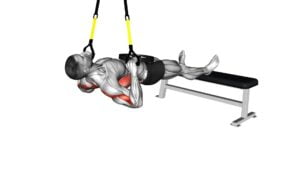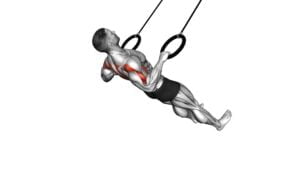Underhand Grip Inverted Back Row – Video Exercise Guide & Tips

Looking to tone and strengthen your upper body? The underhand grip inverted back row is the perfect exercise for you.
Watch This Exercise Video
In this video exercise guide, you'll learn the proper equipment and setup, as well as step-by-step instructions on how to perform the exercise correctly.
Avoid common mistakes and maximize your results with our helpful tips.
Plus, we'll show you variations and progressions to keep challenging yourself.
Get ready to take your workout to the next level!
Key Takeaways
- The underhand grip inverted back row increases upper body strength.
- It improves posture by activating multiple muscles in the upper body.
- The exercise targets the latissimus dorsi, rhomboids, and biceps.
- Different grip positions can be used to target specific muscles.
Benefits of the Underhand Grip Inverted Back Row
You will experience increased upper body strength and improved posture by incorporating the underhand grip inverted back row into your workout routine. This exercise activates multiple muscles in your upper body, including your latissimus dorsi (lats), rhomboids, and biceps.
When performing the underhand grip inverted back row, your lats are heavily engaged as they're responsible for pulling the weight towards your body. This exercise also targets your rhomboids, which are muscles in your upper back that help to retract and stabilize your shoulder blades. Additionally, the underhand grip places more emphasis on your biceps, as they're required to assist in pulling the weight towards you.
A comparison between the underhand grip and overhand grip in the inverted back row reveals that the underhand grip primarily targets the biceps, while the overhand grip focuses more on the lats. By incorporating both grips into your routine, you can effectively target and strengthen different muscle groups in your upper body.
Incorporating the underhand grip inverted back row into your workout routine won't only increase your upper body strength but also improve your posture. By strengthening your back muscles, you can counteract the effects of prolonged sitting and poor posture. So, grab a bar, set yourself up on the inverted row machine, and start reaping the benefits of this exercise for your upper body and posture.
Proper Equipment and Setup
To ensure a successful underhand grip inverted back row, there are a few key points to keep in mind.
First, consider your equipment options, such as using a barbell or cable machine.
Next, focus on correct setup technique, making sure you have a secure grip and a stable stance.
Lastly, prioritize safety by maintaining proper form and using an appropriate weight for your fitness level.
Equipment Options
Ensure proper equipment and setup for the underhand grip inverted back row exercise.
When it comes to equipment options, there are a few things to consider. First, you have the choice of using different grip positions to target specific muscles. For example, a wide grip will focus more on your upper back, while a narrow grip will engage your biceps and lower back.
Additionally, there are alternative equipment options available if you don't have access to a barbell or suspension trainer. You can use dumbbells, resistance bands, or even a cable machine to perform this exercise effectively.
Now that you know the different equipment options, let's move on to discussing the correct setup technique for the underhand grip inverted back row.
Correct Setup Technique
To achieve proper equipment and setup for the underhand grip inverted back row exercise, it's essential to ensure the correct placement of your hands and choose the appropriate equipment for your desired muscle targeting. Here are some tips to help you set up correctly:
- Position your hands shoulder-width apart on the bar, palms facing up.
- Adjust the height of the bar to your chest level to allow for a full range of motion.
- Keep your feet firmly planted on the ground, shoulder-width apart, to maintain stability.
- Engage your core and keep your back straight throughout the exercise.
- Control the movement by pulling your shoulder blades together as you pull yourself up.
Common errors in the setup technique include improper hand placement, using too much or too little weight, and neglecting proper form.
To modify the exercise for different fitness levels, beginners can use resistance bands or perform the exercise with their feet on the ground, while advanced individuals can add weights or perform single-arm variations.
Remember to consult with a fitness professional for personalized guidance.
Safety Considerations
For proper equipment and setup of the underhand grip inverted back row exercise, it's important to consider safety measures. Injury prevention should be a top priority when performing any exercise.
To minimize the risk of injuries, make sure you have the proper equipment, such as a sturdy bar or suspension trainer, and a secure anchor point. Before starting the exercise, check that the equipment is in good condition and can support your weight.
Additionally, maintaining proper form throughout the exercise is crucial for injury prevention. Keep your back straight, engage your core, and avoid excessive swinging or jerking movements.
Step-by-Step Guide to Performing the Exercise
Now let's discuss the key points to keep in mind while performing the underhand grip inverted back row exercise.
First and foremost, it's important to maintain proper form throughout the movement, ensuring that your back is straight and your core is engaged.
This exercise offers several benefits, including strengthening your back muscles and improving posture.
However, it's crucial to avoid common mistakes such as using momentum or rounding your shoulders, as these can diminish the effectiveness of the exercise.
Proper Form for Exercise
Start by positioning yourself under the barbell with an underhand grip. To ensure proper form for the underhand grip inverted back row, follow these steps:
- Stand with your feet shoulder-width apart and your knees slightly bent.
- Grab the barbell with an underhand grip, hands slightly wider than shoulder-width apart.
- Keep your back straight, chest out, and shoulders pulled back.
- Engage your core and maintain a slight bend in your elbows.
- Pull the barbell towards your lower chest, squeezing your shoulder blades together.
Remember to avoid these common mistakes when performing the underhand grip inverted back row:
- Rounding your back or slouching your shoulders.
- Using too much momentum to lift the barbell.
- Holding your breath instead of breathing properly.
- Gripping the barbell too tightly, causing strain on your wrists.
- Pulling the barbell too high, over your chest.
To add variation to your workout, you can try using dumbbells instead of a barbell or incorporating resistance bands for added resistance.
Benefits of Exercise
To maximize the benefits of the underhand grip inverted back row, focus on maintaining proper form throughout the exercise. Regular exercise is important for improving overall health, and this exercise specifically targets the muscles in your upper back, shoulders, and arms. By performing this exercise correctly, you can strengthen your back, improve your posture, and increase your overall upper body strength.
The underhand grip engages different muscles compared to other rowing exercises, providing a unique challenge and helping to develop a balanced physique. Additionally, this exercise can improve your grip strength and increase muscle endurance. Make sure to keep your core engaged, your shoulders down and back, and avoid using momentum to perform the movement.
Now, let's move on to the next section to learn about common mistakes to avoid.
Common Mistakes to Avoid
To perform the underhand grip inverted back row exercise correctly, it's important to avoid these common mistakes:
- Using too much momentum: Focus on engaging your back muscles and avoid swinging your body to complete the movement.
- Failure to maintain proper form: Keep your chest lifted, shoulders pulled back, and core engaged throughout the exercise to prevent strain on your lower back.
- Gripping the bar too tightly: Maintain a relaxed grip to prevent unnecessary tension in your forearms and wrists.
- Rounding your shoulders: Keep your shoulders back and down to ensure proper alignment and target the intended muscles effectively.
- Neglecting to control the descent: Lower yourself back to the starting position in a slow and controlled manner to maximize the benefits of the exercise and reduce the risk of injury.
Common Mistakes to Avoid
You should avoid these common mistakes when performing the Underhand Grip Inverted Back Row. Proper technique is crucial to ensure that you maximize the benefits of this exercise and prevent potential injuries.
One common mistake to avoid is using too much momentum. It can be tempting to use your body's momentum to lift the weight, but this takes away from the effectiveness of the exercise. Instead, focus on using your back muscles to pull the weight towards your chest in a controlled manner.
Another mistake to avoid is rounding your back. This puts unnecessary strain on your spine and can lead to injury. Keep your back straight throughout the movement, engaging your core muscles to maintain stability.
Additionally, it's important to avoid shrugging your shoulders. This can cause tension in your neck and shoulders and takes away from the targeted work on your back muscles. Keep your shoulders relaxed and down as you perform the exercise.
Lastly, make sure to avoid using excessive weight. Using a weight that's too heavy can compromise your form and increase the risk of injury. Start with a weight that allows you to perform the exercise with proper technique and gradually increase the weight as you get stronger.
Tips for Maximizing Your Results
To get the most out of your Underhand Grip Inverted Back Row exercise and maximize your results, focus on maintaining proper form and incorporating these tips:
- Engage your core: Keep your abs tight throughout the exercise to stabilize your body and maximize muscle activation in your back.
- Squeeze your shoulder blades: As you pull the bar towards your chest, focus on squeezing your shoulder blades together. This will help to engage your back muscles more effectively.
- Use a challenging weight: To see optimal results, choose a weight that challenges you while still allowing you to maintain proper form. This will ensure that your muscles are being adequately stimulated.
- Incorporate supersets: To increase the intensity of your workout and maximize muscle activation, consider incorporating supersets. This involves performing another exercise immediately after your set of Underhand Grip Inverted Back Rows, targeting a different muscle group.
- Rest and recover: Giving your muscles time to rest and recover is essential for maximizing your results. Aim for at least 48 hours of rest between workouts targeting the same muscle group.
Variations and Progressions to Try
To further enhance your workout routine, consider incorporating different variations and progressions of the Underhand Grip Inverted Back Row exercise. By adding these variations and progressions, you can challenge your muscles in new ways and continue to make progress towards your fitness goals.
One simple variation to try is the wide grip underhand inverted back row. Instead of using a shoulder-width grip, move your hands wider apart on the bar. This will place more emphasis on your lats and upper back muscles, providing a different stimulus to your muscles.
Another variation is the single-arm underhand inverted back row. Instead of using both arms to row the bar, perform the exercise one arm at a time. This will require more stability and core engagement as you balance your body while rowing.
To progress the exercise, you can increase the weight you're using. Gradually add more weight to challenge your muscles and continue to build strength. Additionally, you can increase the number of reps or sets you perform, or decrease the rest time between sets to increase the intensity of the exercise.
Incorporating these variations and progressions into your workout routine will keep your workouts interesting and help you continue to make progress. Remember to always use proper form and listen to your body to prevent injury.
Frequently Asked Questions
How Does the Underhand Grip in the Inverted Back Row Differ From Other Back Row Exercises?
When performing the underhand grip in the inverted back row, you'll notice some key differences from other back row exercises.
This grip targets your biceps more effectively and allows for a greater range of motion.
By using different grips, such as overhand or neutral, you can vary the intensity and engage different muscle groups.
Incorporating the underhand grip in your back row routine can enhance your strength, build muscle, and improve overall upper body strength.
Can the Underhand Grip Inverted Back Row Be Modified for Individuals With Limited Upper Body Strength?
If you have limited upper body strength, there are modified variations and alternatives for the underhand grip inverted back row. These modifications can help you still work your back muscles effectively without straining your upper body too much.
By adjusting the weight, using resistance bands, or performing seated variations, you can tailor the exercise to your strength level.
It's important to listen to your body and choose the variation that feels comfortable and safe for you.
Are There Any Specific Muscle Groups That the Underhand Grip Inverted Back Row Targets?
The underhand grip inverted back row targets specific muscle groups in your upper body. It primarily works your back muscles, particularly the latissimus dorsi and rhomboids. This exercise also engages your biceps, forearms, and shoulders.
If you have limited upper body strength, there are modifications you can make to make it more manageable. Talk to a fitness professional to learn the best modifications for your specific needs.
How Often Should the Underhand Grip Inverted Back Row Be Incorporated Into a Workout Routine?
To effectively incorporate the underhand grip inverted back row into your workout routine, it's important to consider frequency.
The benefits of this exercise make it a valuable addition to your strength training regimen. By targeting multiple muscle groups, such as the back, biceps, and shoulders, it helps improve posture and upper body strength.
Aim to perform this exercise 2-3 times a week, allowing for adequate rest and recovery between sessions.
Are There Any Potential Risks or Precautions to Be Aware of When Performing the Underhand Grip Inverted Back Row?
When performing the underhand grip inverted back row, there are a few potential risks and precautions to keep in mind. It's important to maintain proper form throughout the exercise to prevent injury.
Be cautious of any back or shoulder discomfort and adjust your technique accordingly.
Start with a weight that's manageable for you and gradually increase as you build strength.
Remember to warm up before starting and listen to your body to avoid overexertion.
Conclusion
In conclusion, the underhand grip inverted back row is a beneficial exercise that targets multiple muscles in the upper body. By using the proper equipment and following the step-by-step guide, you can perform this exercise effectively.
Avoid common mistakes and follow the tips provided to maximize your results. Additionally, consider trying variations and progressions to challenge yourself further.
Incorporating this exercise into your routine can help improve your strength and overall fitness level.

Author
Years ago, the spark of my life’s passion ignited in my mind the moment I stepped into the local gym for the first time. The inaugural bead of perspiration, the initial endeavor, the very first surge of endorphins, and a sense of pride that washed over me post-workout marked the beginning of my deep-seated interest in strength sports, fitness, and sports nutrition. This very curiosity blossomed rapidly into a profound fascination, propelling me to earn a Master’s degree in Physical Education from the Academy of Physical Education in Krakow, followed by a Sports Manager diploma from the Jagiellonian University. My journey of growth led me to gain more specialized qualifications, such as being a certified personal trainer with a focus on sports dietetics, a lifeguard, and an instructor for wellness and corrective gymnastics. Theoretical knowledge paired seamlessly with practical experience, reinforcing my belief that the transformation of individuals under my guidance was also a reflection of my personal growth. This belief holds true even today. Each day, I strive to push the boundaries and explore new realms. These realms gently elevate me to greater heights. The unique combination of passion for my field and the continuous quest for growth fuels my drive to break new ground.







